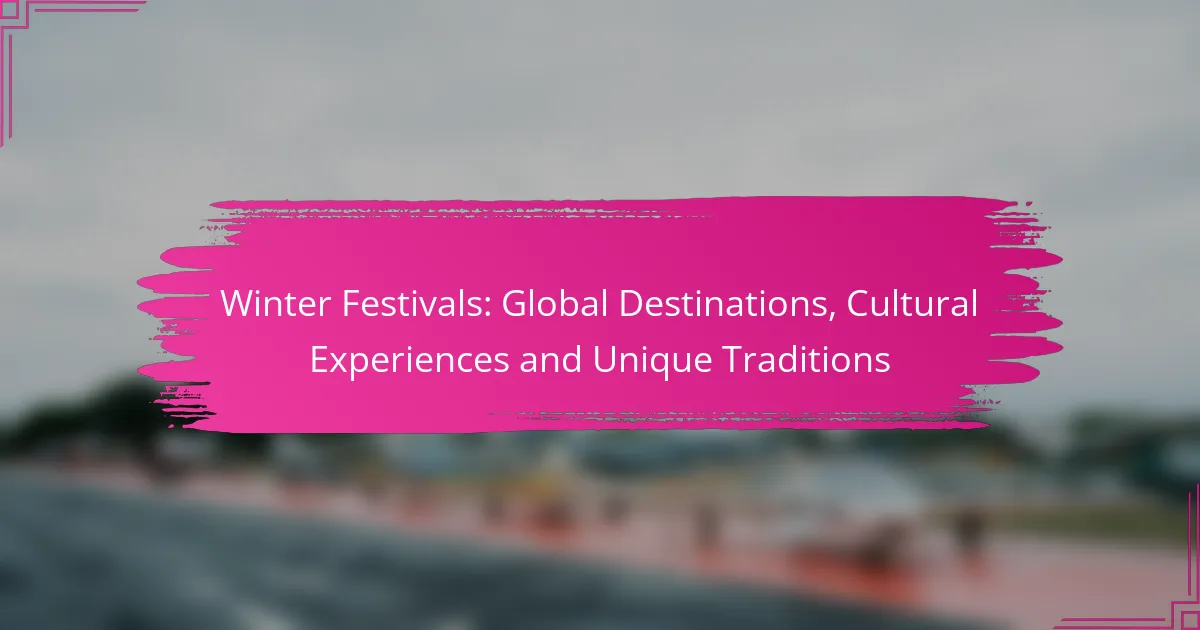Winter festivals around the world provide a captivating glimpse into diverse cultural traditions, celebrating the season with vibrant activities and unique local customs. From festive markets to traditional performances, these events invite visitors to immerse themselves in the rich heritage and communal spirit of each region. Experience the joy of winter through food, music, and crafts that highlight the distinct flavors of local culture.
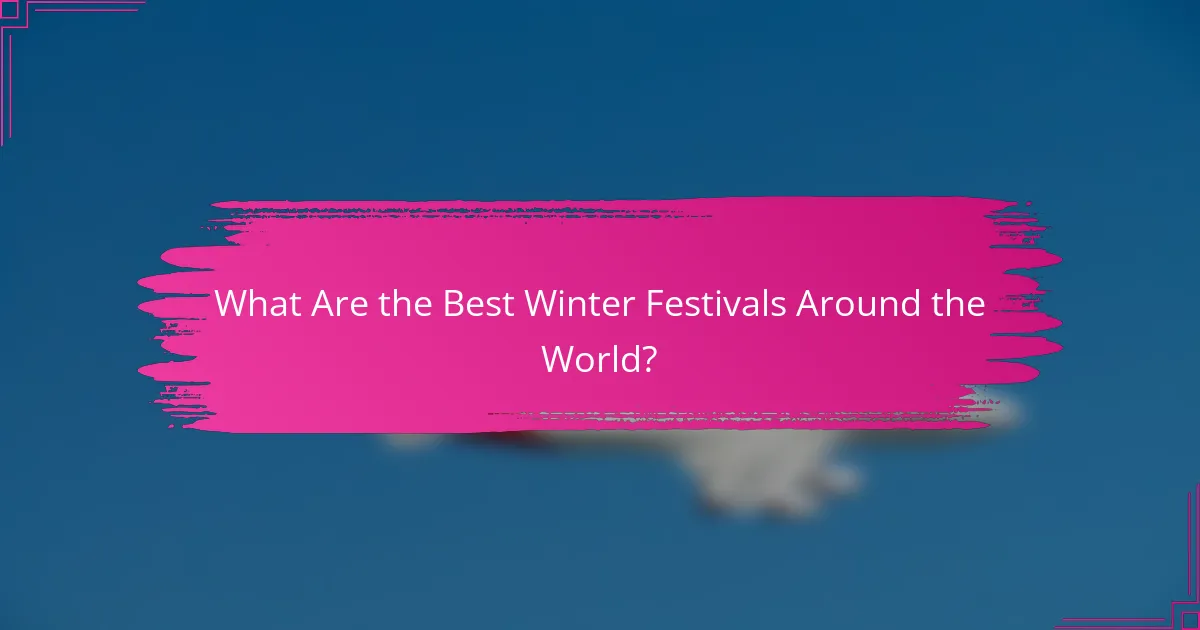
What Are the Best Winter Festivals Around the World?
Winter festivals around the globe offer unique cultural experiences, showcasing local traditions, food, and entertainment. Some of the best-known festivals attract millions of visitors each year, providing a festive atmosphere filled with activities and celebrations.
Harbin Ice Festival in China
The Harbin Ice Festival is one of the largest and most spectacular winter festivals, held annually in Harbin, Heilongjiang Province. It features massive ice sculptures, some reaching several meters in height, illuminated by colorful lights. Visitors can explore the Ice and Snow World, where they can enjoy ice skating, sledding, and even ice swimming.
To make the most of your visit, plan to go in January when the festival is at its peak. Dress warmly, as temperatures can drop significantly, often below -20°C. Tickets typically range from CNY 300 to CNY 500, depending on the attractions you wish to access.
Quebec Winter Carnival in Canada
The Quebec Winter Carnival is a vibrant celebration of winter, held in Quebec City each February. This festival features a variety of activities, including parades, ice sculptures, and traditional Quebecois music and cuisine. The iconic Bonhomme Carnaval, a snowman mascot, is a central figure, welcoming visitors to join in the festivities.
Visitors should consider purchasing a Carnival pass, which grants access to many events and activities for around CAD 20. Be prepared for cold weather, with temperatures often hovering around -10°C to -20°C, and dress in layers to stay comfortable while enjoying the outdoor events.
Christkindlesmarkt in Germany
The Christkindlesmarkt is a traditional Christmas market held in various cities across Germany, with the most famous located in Nuremberg. This festive market features wooden stalls selling handcrafted goods, seasonal foods, and mulled wine. The atmosphere is enhanced by live music and performances, making it a delightful experience for visitors.
To fully enjoy the market, visit in late November through December. Prices for food and drinks typically range from EUR 3 to EUR 10, allowing for a budget-friendly outing. Arrive early in the day to avoid crowds and enjoy a leisurely stroll through the stalls.
Fête de la Saint-Sylvestre in France
Fête de la Saint-Sylvestre, or New Year’s Eve, is celebrated across France with lively parties, fireworks, and festive meals. Major cities like Paris host grand celebrations, including a spectacular fireworks display at the Eiffel Tower. Traditional French cuisine, including foie gras and champagne, is often enjoyed during this festive night.
Reservations at restaurants are highly recommended, as many places fill up quickly. Expect to spend around EUR 100 or more per person for a special New Year’s Eve dinner. Dress elegantly, as many events have a formal dress code.
Winter Wonderland in London
Winter Wonderland is a popular annual event held in Hyde Park, London, featuring a Christmas market, ice skating rink, and various attractions. The festival runs from mid-November to early January, offering a magical atmosphere with festive lights and entertainment. Visitors can enjoy rides, food stalls, and live performances throughout the event.
Entry to Winter Wonderland is free, but attractions may require tickets, typically ranging from GBP 5 to GBP 15. Plan your visit on weekdays to avoid large crowds and consider arriving early to enjoy all the activities without rushing.
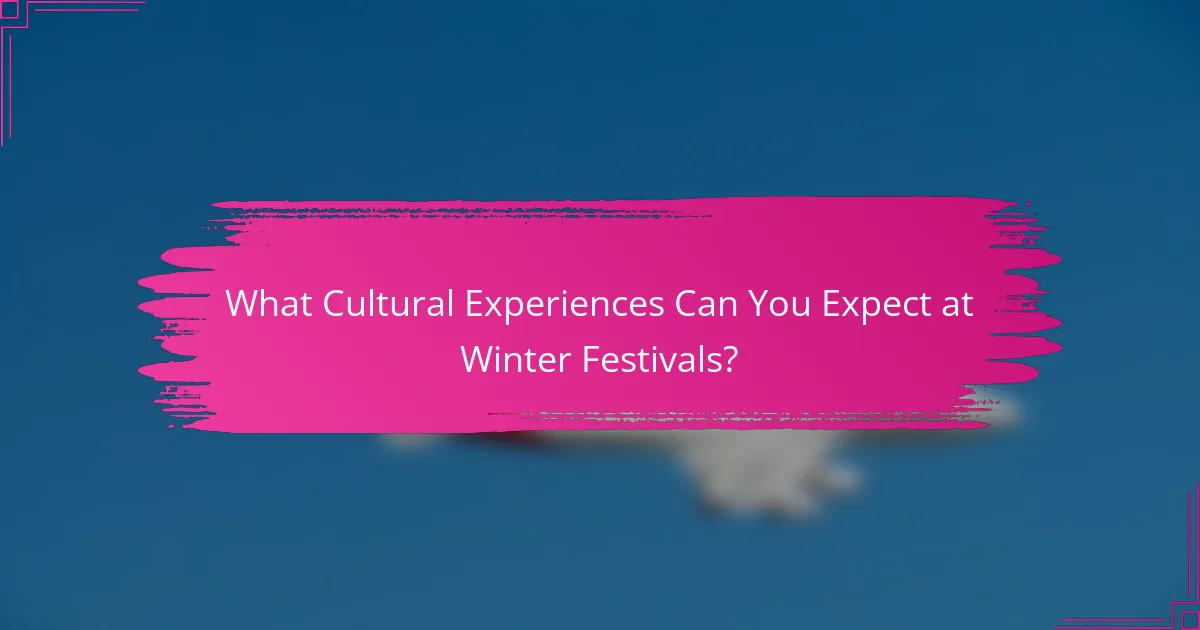
What Cultural Experiences Can You Expect at Winter Festivals?
Winter festivals offer a rich tapestry of cultural experiences that reflect the unique traditions of each region. Attendees can immerse themselves in local customs through food, music, crafts, and activities that celebrate the season.
Traditional Food and Drink
At winter festivals, traditional food and drink play a central role in the celebration of local culture. Visitors can savor hearty dishes such as stews, roasted meats, and seasonal vegetables, often accompanied by warm beverages like mulled wine or spiced cider.
In many regions, street vendors and festival stalls showcase local specialties. For example, in Germany, you might find bratwurst and pretzels, while in Canada, poutine and maple treats are popular. Sampling these delights is an essential part of the experience.
Local Music and Dance Performances
Music and dance performances are vital components of winter festivals, often featuring traditional styles that reflect the area’s heritage. Expect to see folk dancers in colorful costumes, accompanied by live bands playing regional instruments.
In places like Scotland, ceilidh dances invite festival-goers to participate, while in Eastern Europe, you might enjoy lively polka music. These performances not only entertain but also foster community spirit and cultural pride.
Artisan Markets and Craft Fairs
Artisan markets and craft fairs are common at winter festivals, showcasing handmade goods that highlight local craftsmanship. Visitors can browse stalls filled with unique items such as pottery, textiles, and jewelry, perfect for holiday gifts.
These markets often emphasize sustainability, with many artisans using traditional techniques and local materials. Engaging with vendors provides insight into the cultural significance of their crafts, making for a meaningful shopping experience.
Winter Sports and Activities
Winter festivals frequently feature a variety of sports and activities that take advantage of the snowy landscape. Common options include ice skating, sledding, and skiing, which cater to both beginners and experienced enthusiasts.
In regions known for winter sports, such as the Alps or the Rockies, festivals may host competitions or demonstrations. Participating in these activities not only adds excitement but also allows visitors to appreciate the natural beauty of the winter season.
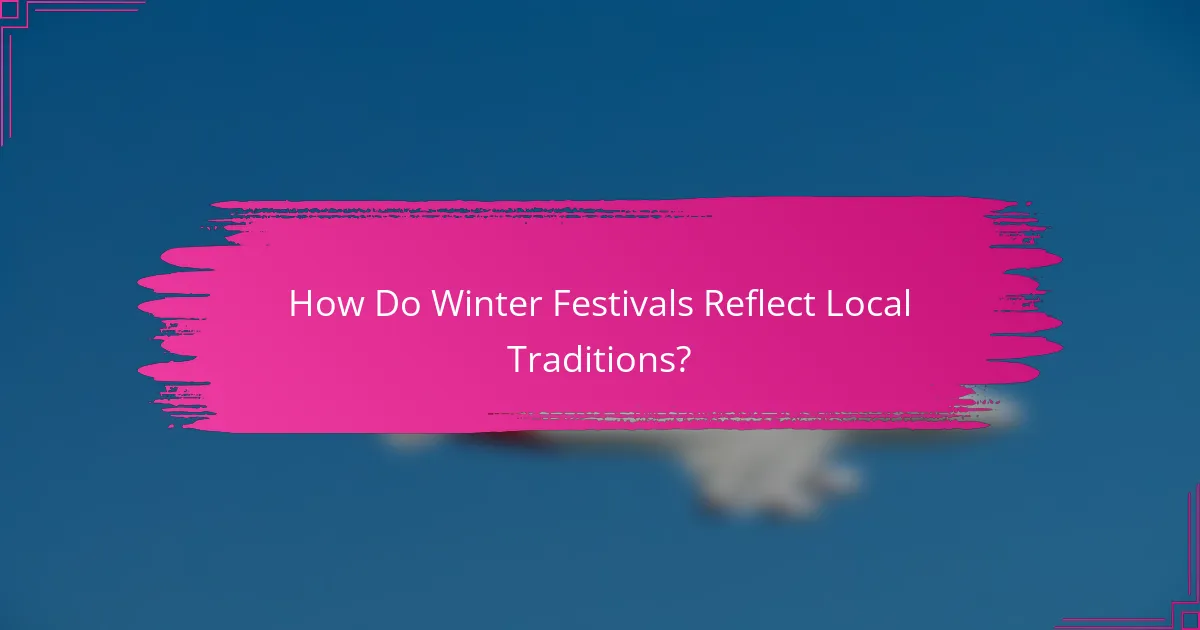
How Do Winter Festivals Reflect Local Traditions?
Winter festivals serve as vibrant expressions of local traditions, showcasing cultural heritage through unique celebrations. These events often incorporate historical practices, regional customs, and community participation, making them a vital part of local identity.
Historical Significance of Celebrations
Many winter festivals have roots in ancient agricultural practices, marking the end of harvest seasons or the arrival of winter. For instance, the Winter Solstice celebrations in various cultures symbolize the rebirth of the sun and the return of longer days.
These historical celebrations often include rituals and customs passed down through generations, reflecting the values and beliefs of the community. Understanding their origins can enhance appreciation for the festivities and their significance in contemporary society.
Regional Variations in Customs
Winter festivals vary widely across regions, influenced by local climate, history, and cultural practices. For example, in Europe, Christmas markets are popular, featuring local crafts and seasonal foods, while in Japan, the Sapporo Snow Festival showcases intricate ice sculptures and winter sports.
These regional differences highlight the diverse ways communities celebrate winter, often incorporating local ingredients, music, and art forms. Participating in these unique customs can provide deeper insights into the local culture and traditions.
Community Involvement and Participation
Community involvement is a cornerstone of winter festivals, with local residents often taking active roles in planning and executing events. This participation fosters a sense of belonging and pride, as people come together to celebrate their shared heritage.
Festivals may include volunteer opportunities, workshops, and performances, encouraging everyone to contribute. Engaging with these activities not only enriches the festival experience but also strengthens community bonds and promotes cultural continuity.
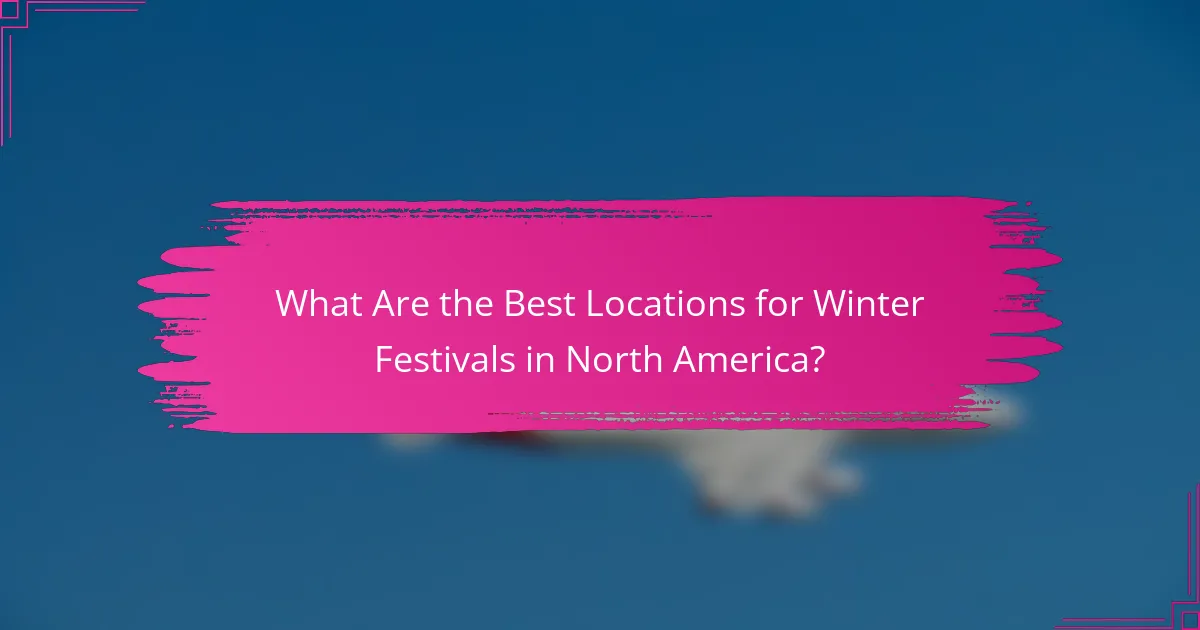
What Are the Best Locations for Winter Festivals in North America?
North America offers a variety of vibrant winter festivals that showcase unique cultural experiences and traditions. Key locations include Lake Tahoe, Montreal, and New York City, each providing distinct celebrations that attract visitors from around the world.
Lake Tahoe, California
Lake Tahoe is renowned for its stunning winter landscapes and outdoor activities. The area hosts the annual SnowGlobe Music Festival, which combines live music with winter sports, creating a festive atmosphere for attendees.
Visitors can enjoy skiing, snowboarding, and snowshoeing during the day, followed by evening concerts. Accommodations range from cozy lodges to luxury resorts, catering to various budgets.
Montreal, Quebec
Montreal’s winter festival scene is highlighted by the Montreal en Lumière festival, which celebrates arts and gastronomy. This event features light installations, outdoor performances, and a diverse range of culinary experiences.
With activities like ice skating and outdoor concerts, the festival transforms the city into a winter wonderland. Expect to see local food vendors and artisans showcasing Quebecois culture, making it a perfect destination for cultural immersion.
New York City, New York
New York City is famous for its iconic winter celebrations, including the Rockefeller Center Christmas Tree Lighting and the Times Square New Year’s Eve Ball Drop. These events draw massive crowds and create a lively holiday spirit throughout the city.
In addition to these major attractions, visitors can explore holiday markets, ice skating rinks, and festive window displays. Be prepared for cold weather and large crowds, and consider booking accommodations well in advance to secure the best options.

How to Choose the Right Winter Festival for Your Experience?
Selecting the right winter festival involves understanding your personal interests, evaluating travel logistics, and checking the event schedule. By considering these factors, you can ensure a fulfilling and enjoyable experience that aligns with your preferences.
Consider Your Interests and Preferences
Your interests play a crucial role in choosing a winter festival. If you enjoy traditional cultural experiences, look for festivals that highlight local customs, food, and music. Alternatively, if you prefer modern celebrations, seek out events featuring contemporary performances or winter sports.
Think about the type of atmosphere you want to experience. Some festivals are lively and crowded, while others offer a more intimate setting. Researching past events can help you gauge what to expect and find a festival that resonates with your personal style.
Evaluate Accessibility and Travel Options
Accessibility is key when choosing a winter festival. Consider how easy it is to reach the destination, including available transportation options such as flights, trains, or buses. Look for festivals in cities with good infrastructure to facilitate your travel.
Additionally, check local accommodations and their proximity to the festival site. Booking a place within walking distance can save time and enhance your experience. Be mindful of seasonal travel trends, as some locations may be busier during peak festival times.
Check Dates and Duration of Events
Understanding the dates and duration of winter festivals is essential for planning your visit. Some festivals last only a weekend, while others may span several weeks. Make sure to verify the specific dates and any special events or activities happening during your stay.
Consider your own schedule and how much time you can dedicate to the festival. If you’re traveling from afar, you may want to extend your trip to explore the surrounding area. Always check for any last-minute changes to the event schedule that could affect your plans.

What Are the Costs Associated with Attending Winter Festivals?
Attending winter festivals can involve various costs, including travel, accommodation, food, and festival entry fees. These expenses can vary significantly based on the festival’s location, duration, and the activities offered.
Travel Expenses
Travel costs to winter festivals depend on the distance and mode of transportation. For local festivals, driving may be economical, while international events could require flights, which can range from a few hundred to over a thousand dollars. Consider booking in advance to secure better rates.
Accommodation Costs
Accommodation prices can vary widely based on the festival’s location and the type of lodging. Budget options like hostels may start around $20 per night, while hotels can range from $100 to several hundred dollars per night during peak festival times. Early booking often yields better deals.
Food and Beverage Expenses
Food costs at winter festivals can add up quickly, especially if you opt for festival vendors. Expect to spend around $10 to $20 per meal. Bringing snacks or meals can help reduce expenses, but be mindful of any venue restrictions on outside food.
Festival Entry Fees
Entry fees for winter festivals can vary, typically ranging from free to around $50 per person. Some events may offer discounts for early registration or group bookings. Always check the festival’s official website for the most accurate pricing and any additional costs for special activities.
Additional Costs
Consider other potential expenses such as souvenirs, parking fees, and transportation within the festival area. Budgeting an extra 20-30% for unexpected costs can help ensure a more enjoyable experience without financial stress.
